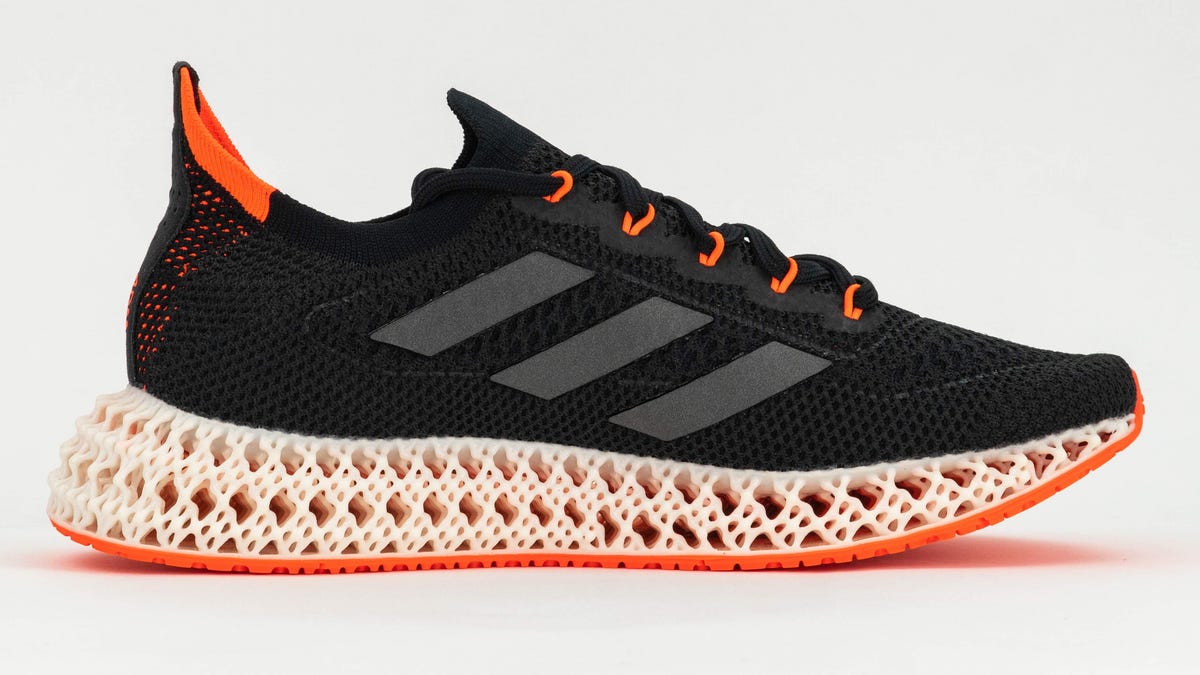Adidas running shoes with 3D printed midsoles push your feet forward
3D-printing firm Carbon makes the airy lattice that cushions runners' feet.

Adidas' 4DFWD shoes use a midsole 3D printed by Carbon.
A new Adidas running shoe called the 4DFWD has a technology-enabled trick: The shoe eases you forward a little each time your foot strikes the ground.
That's because the shoe's 3D-printed midsole, made by Carbon, is an airy lattice pierced by bow-tie-shaped holes. When compressed, its squashing motion advances your foot compared with the position of the sole on the ground. Conventional midsoles, by comparison, just compress downward so your foot mashes harder against the front of the shoe.
Adidas and Carbon say the redesigned midsole -- the part of the shoe that sits just above the rubbery tread -- cuts the braking force pushing against the front of your foot by 15% compared with an ordinary shoe. The companies unveiled the 4DFWD on Wednesday.
"We identified one perfect lattice midsole that is designed to compress forwards under loading and counter mechanical forces whilst delivering a unique gliding sensation for our runners," Sam Handy, Adidas' vice president of design for running shoes, said in a statement.
The new show design illustrates the radical changes in manufacturing made possible by 3D printing. By building products layer by layer, it's possible to construct designs that would be impossible with conventional casting, molding, extrusion or machining. Although 3D printing got its commercial start creating prototypes, the technique is increasingly being used for production.
A recent survey of 1,900 3D companies found that 52% are using 3D printing to manufacture products, not just prototypes, according to Sculpteo, a 3D-printing subsidiary of German chemical giant BASF. Top uses for 3D printing are making complex shapes and "mass customization," the ability to manufacture products that are digitally fine tuned for individuals.
The biggest challenges for 3D printing, also called additive manufacturing, are consistency from one manufacturing run to another, the amount of post-processing required before printed items can be used, and the cost of the raw materials the printers use, the survey found.
Carbon's manufacturing process, called Digital Light Synthesis, is different from most 3D printing. It beams carefully directed ultraviolet light upward into a thin pool of liquid resin that solidifies in the light. As the product takes shape, it's gradually lifted and new resin solidifies below continuously. The result is a material that's more consistent and that's equally strong in all directions, Carbon says.
3D printers won new attention during the coronavirus pandemic, when companies and households found them useful to produce personal protective equipment like face shields.
The lattice midsole in Adidas' 4DFWD shoes, 3D printed by Carbon, have bowtie shaped voids that help move the top of the shoe forward when a runner's foot hits the ground and compresses the midsole.
Adidas and Carbon evaluated 5 million possible lattice structures before settling on the bowtie pattern for the 4WFWD. They tested the design with real runners and at the University of Calgary and University of Arizona.
The shoes are expected to go on sale July 1 for about $240.

